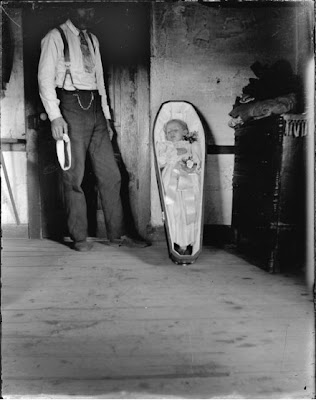The incredible but perennially darrrrrk, site/blog American Suburb X has some interesting images from Michael Lesy's first book Wisconsin Death Trip up on its site here. Appropriate for me, given recent events (see below, and eventually above). I think that Wisconsin Death Trip was, not only my first introduction to the darker side of American life through photographs ('Through a glass darkly', fer sure) but a real introduction to social history through photography - little did my 18 year old self know it at the time. Lesy originally conducted the research that became the book in the mid-seventies when he discovered over five thousand collodian glass plate negatives attributed to one photographer, a Mr. Charles Van Schaik, literally cracking under their own weight in the attic above the former studio. Active between 1895 and 1935 in and around the small town of Black River Falls, Wisconsin. Van Schaik set about recording for posterity as well as financial enumeration, the local population consisted mainly of incredibly disaffected Scandinavian's who, having been shown postcards of gigantic vegetables by American agents tricking them into believing how fertile the land in that part of the United States was, soon found themselves sitting penniless atop barren land that even the Heathen Indians wouldn't touch. This generally resulted in a decade long spate of rather inventive acts of homicide, infanticide, filicide and suicide topped off with the occasional bout of Cocaine addiction/window smashing, miserable alcoholic dwarfs as well as a plenitude of reports of ghosts, witches, madness and despair.
Not only was an amazing amount of this captured and preserved above a shop for nearly a hundred years on literally thousands of wet plate collodian glass negatives, but Lesy comfortably accompanies the images with accounts from the local paper The Black River Falls as well as reports of recently inducted 'guests' of the nearby Mendoza State Insane Asylum, the three of which, between them make for some incredibly amazing parrallels of fact such as the recurring and continuing story of the woman who was addicted to the relatively new drug Cocaine and would, on occasion leave her husband, take the train to a nearby town and commence to smashing as many windows as she could before being arrested and sent to the local asylum (I believe thats her above, against the wall). The fact that the photographer, newspaper and asylum made frequent and regular reports of her antics and that Lesy managed to connect the dots between them is to me the stand out story from this whole collection of what is esentially a very strange and dark chapter in American history that historians and filmakers have so far shied away from depicting.
As a part aside, around about ten years ago (and, i have to say, my first introduction to this book) the BBC commissioned a film - I believe what they now call a 'docu-drama' - based on Lesy's original book, featuring such fictionalised recreations of some of the most interesting stories and featuring the voice of none other than Ian 'look out! he's a robot!' Holme as the author of the newspaper reports. As part of the BBC's then revered Storyville format, it is an excellent film/documentary but seriously suffers from the fact that it doesn't quite know exactly what it is: Given its structure and at just over an hour it is too short to be a 'proper film' but too clever to be 'just a documentary' and definately leaves one wanting more from these strange, dark tales. It is beautifully filmed (in or near the original setting) and incredibly, has a rather anachronistic soundtrack featuring many track from DJ Shadow's first album Endtroducing (again, a first intro for me) and which, instead of being utterly jarring like one would expect, works incredibly well, serving to add to the tense, surreal and ultimately cloying atmosphere that the film seeks out and serves, and not to mention over ten years before tarantino made it suddenly cool to do. The DVD release even comes with an accompanying 'making of' documentary but is sadly lacking in any more information as to the formation of the book and to Michael Lesy's own inter-twining personal biography within it, which in itself I find utterly fascinating. If I were you I would be searching out both right now.




No comments:
Post a Comment